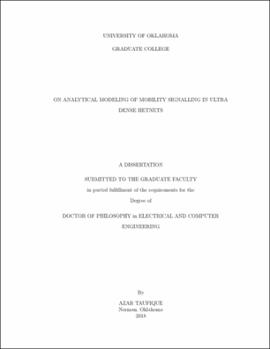| dc.description.abstract | Multi-band and multi-tier network densification is being considered as the most promising solution to overcome the capacity crunch problem in emerging cellular networks. To this end, small cells (SCs) are being deployed within macro cells
(MC) to off-load some of the users associated with the MCs. This deployment scenario gives birth to several new problems. Amongst others, handovers (HOs), signalling overhead and mobility management are becoming increasingly critical
challenges. Frequent HOs in ultra-dense SC deployments can lead to a degraded mobility performance and increase signalling overhead significantly. Recently, a new cellular architecture with control/data plane separation has been proposed to
overcome these challenges. However, the state of the art analysis of the feasibility of the CDSA remains mostly qualitative. There is dire need for mathematical models to analyze the performance of various aspects of CDSA and quantify its gains, if
any, compared to conventional architecture. In this dissertation, we derive several analytical models to compare HO performance in the control/data separation architecture (CDSA) and conventionally deployed networks under various scenarios
and configurations. Our developed mathematical framework advances the state of the art by considering HO success, HO failure and no HO scenarios. The proposed models can be used to quantify HO signalling as a function of key cellular system
design parameter such as cell density, session duration, velocity, HO duration(s) and intercell overlap coverage factor. Using the developed analytical models, we perform a comparative analysis of HO signalling generated during various HO scenarios in
CDSA and conventionally deployed networks. Building on the insights drawn from this analysis, we introduce new parameters for improving the HO execution process in emerging cellular networks viz-a-viz 5G and beyond. These new parameters,
when tuned optimally, can significantly reduce the HO signalling load. Closed form expressions are also derived for continuous and continual (intermittent) mobility scenarios, while considering both HO success and HO failure likelihoods. In addition,
we propose an analytical model which enables more radio resource efficient network planning by quantifying HO signalling and success probabilities as function of intercell overlap coverage factor. Analysis indicates that cell density, actual HO
time duration and average velocity can be used as the key metrics to optimally plan intercell overlap coverage factor in order to minimize mobility signalling load. Numerical results and analysis based on the developed overall analytical framework
indicate that, compared to conventional networks, CDSA offers promising gains in terms HO performance and reduced HO signaling overhead. | en_US |
